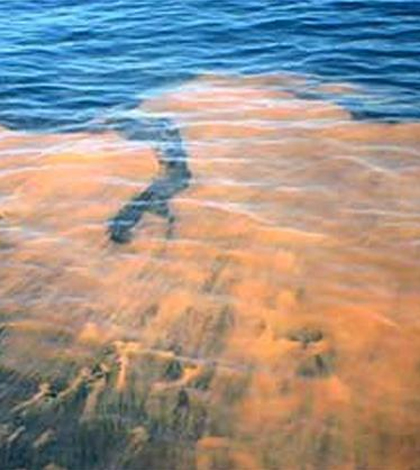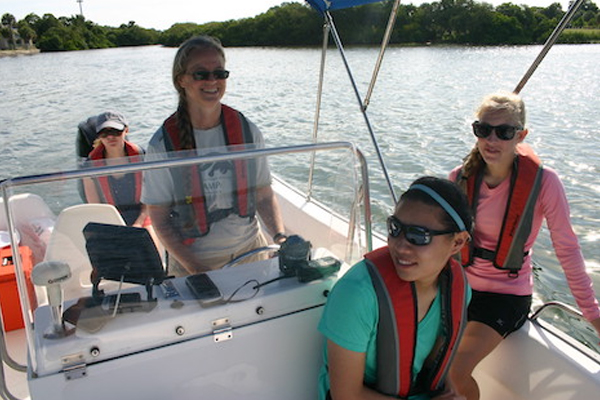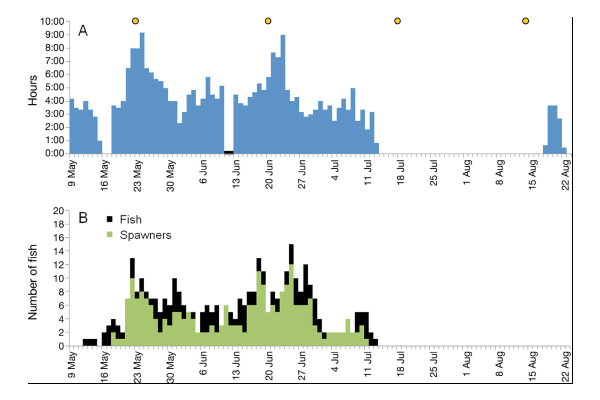Acoustic Recorder Technology Proves Valuable In Capturing Massive Red Tide Event

Red tide. (Credit: NOAA)
What began as a fish spawning study in Tampa Bay a decade ago has resulted in an excellent case study on the usefulness of acoustic recording technology. That’s because underwater recorders used in the investigation captured the utter silence brought about by the sudden rise of a red tide event occurring there in 2005.
The harmful bloom developed after populations of the dinoflagellate Karenia brevis began to surge in the bay. The organism is known to produce strong neurotoxins that can affect the central nervous systems of marine creatures, which may have played a role in some of the silence that scientists recorded.
Researchers at Eckerd College led the study that started with the goal of assessing sounds from spawning and other activities given off from sea trout, silver perch, dolphins and snapping shrimp in the bay. Others from the University of South Florida and the Florida Fish and Wildlife Conservation Commission also took part. They used passive acoustic recorders (underwater microphones) to gauge the creatures’ activity. Acoustic telemetry tags were also implanted in many of the fish to study their movements in the bay.
Scientists say that each of the underwater animals give off specific sounds that allow them to be tracked easily. For dolphins, these include hi-frequency whistles or echo-location clicking noises. Snapping shrimp also make clicking sounds, but they’re lower in frequency and less patterned than ones made by dolphins. Sea trout and silver perch, meanwhile, will make calling noises using their swim bladders. They contract muscles around their bladders, which results in rapid popping sounds.

Researchers survey Tampa Bay during the investigation. (Credit: Eckerd College)
Acoustic recorders deployed around the bay, programmed to track sounds every 10 seconds and log them every 10 minutes, were monitoring well before the red tide event came in. And so plenty of underwater clicking and popping were recorded before the disaster.
“We ran it (the study) for a few years, mostly focused during the summer time — spring through summer. The red tide, we weren’t there to study it. I remember it came through pretty dramatically,” said David Mann, one of the study’s co-authors who was an associate professor of marine science at University of South Florida during the investigation. He is now president of Loggerhead Instruments, a company working to expand the use of acoustic technologies in marine studies. “There were dead fish floating by and plankton in the water were discolored.”
Mann says that the silence recorded thereafter was expected. But it is surprising for at least one reason. Snapping shrimp, long believed to be resistant to the effects of red tide, were not recorded during the bloom. The silent soundscape is proof that they at least feel some impacts. As for the other subjects of the study, it’s not clear to the researchers if they died from effects of the red tide or simply moved out of the area.
But the silent recordings gleaned during the period underscore just how effective that acoustic recording technology can be, Mann says. And he, along with other researchers on the project, are looking to expand its use throughout the research world.
“One of the ultimate goals is to spread the technology to listen in the ocean over broad scales,” said Mann. “It hasn’t gotten to a point where people have stations always running and one of my goals is to get it there.”

Sea Trout, Cynoscion nebulosus. (A) Duration of daily aggregation sound. The black marker on 11 and 12 June indicates equipment failure. Full moons are represented by yellow circles. (B) Number of fish detected by date regardless of location indicated by black bars, and the number of spawning fish are indicated by green bars. (Credit: Sue Lowerre-Barbieri / University of Florida)
There are challenges in reaching that goal, like the fact that taking sound recordings around the clock can result in large amounts of data. But that is something that has become less of an issue with time. As an example, Mann says that the memory cards used during the Tampa Bay investigation came in at 128 megabytes. Nowadays, that’s sort of puny compared to the 512-gigabyte memory options out there.
Going off that, another issue is processing the data. Since there are such large amounts to sift through, Mann says the technology needs to be improved so that data reduction can be performed on sensors themselves.
But on the plus side, there are lots of good reasons to consider using the technology in monitoring projects. Like the fact that biofouling isn’t a big issue for the acoustic recorders like it is for other water quality sensors.
“Costs are coming down. When we started, there were few places to buy recorders but there’s more price competition now. With the larger memory cards, field costs have gone down because you don’t have to go out in a boat as much, which is the most expensive part most of the time,” said Mann. “The thing that needs to happen is to transition people away from looking at bioacoustics for just fish folks (researchers). That’s happened with sonar and other technologies and I think the market will grow to make it (bioacoustics) an accepted tool in marine research.”
Top image: Red tide. (Credit: NOAA)





0 comments